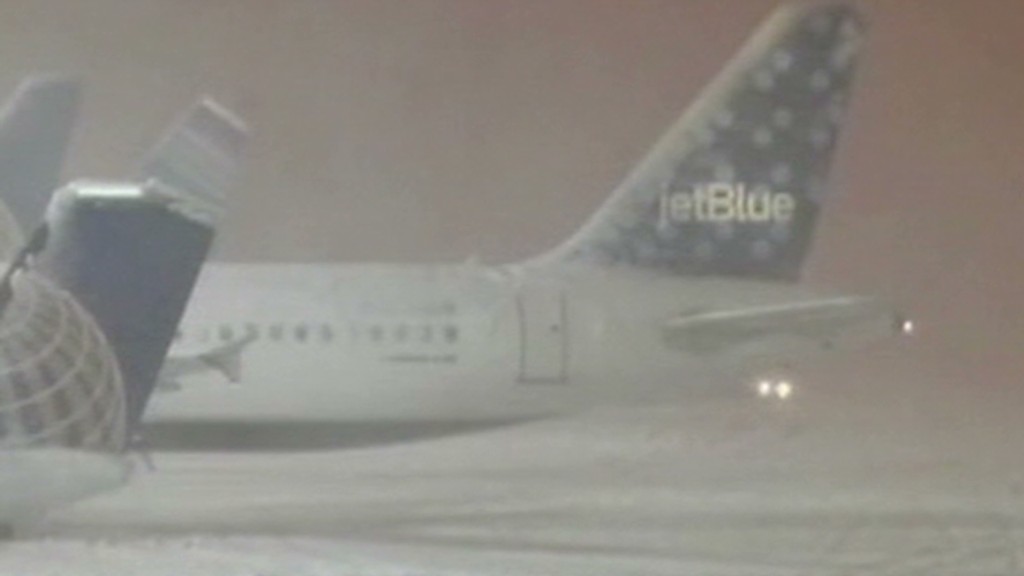
It's every airline's nightmare: Some of your busiest operations grinding to a halt.
That's what happened to JetBlue Airways this week, inconveniencing tens of thousands of customers and raising questions about its basic competence.
JetBlue said it was forced to essentially shut operations at Boston's Logan International Airport and the three New York-area airports. While other carriers have canceled flights, none has had to halt all operations at key airports.
Several days of bad weather and runway closings at New York's JFK airport on Friday and Sunday sparked cascading delays -- and the delays in turn caused JetBlue to run out of available pilots.
JetBlue said it canceled 435 flights Monday, affecting 49,000 passengers, in part due to new Federal Aviation Administration rules that went into effect last week requiring more rest for pilots between flights. Some 150,000 JetBlue passengers have been affected by cancellations over the past six days.
"The old pilot rules were somewhat more forgiving in terms of how much delay you could operate with," JetBlue chief operating officer Rob Maruster said in a conference call with reporters Tuesday. He agreed with a questioner who said it was "a bad time" for the implementation of the rule.
Maruster said it was too early to provide a cost estimate for the debacle. In a post on its website Tuesday, the company outlined its compensation plans for customers who experienced multiple cancellations, offering credits, frequent flier points and free tickets.
Maruster said the last of the stranded travelers should be taken care of by Thursday.
"We have resumed departures from both New York and Boston, and the recovery looks very good right now," he said. "All decisions were made for safety reasons."
Related: Polar vortex keeps on swinging, stranding thousands
Some experts say the airline should have been better prepared for the events of the past few days.
"Tying it to the storm and the FAA is a way to deflect criticism, in my opinion. In reality, I think they simply screwed up," said Mark Murphy, founder of TravelPulse.com. "Case in point: Look at what's happening with other carriers. Same storm? Yes. Same FAA rules going into effect? Yes. Same disruptions? No."
JetBlue representatives said that other airlines had also likely experienced challenges with the implementation of the FAA rule, but simply hadn't been as forthcoming about it.
FAA spokeswoman Laura Brown told CNN Tuesday that JetBlue last year requested an extension to the Jan. 4, 2014, work hour rules deadline.
JetBlue was the only airline to request an extension, she said. In October, the FAA sent JetBlue a letter declining that request.
JetBlue is also the only major airline whose pilots do not belong to a union. Union contracts at other airlines frequently have rest requirements that exceed the new rules, so the rule changes do not affect those carriers as much as they would JetBlue.
The new rest requirements were implemented after an investigation into a crash by a regional jet in Buffalo in February 2009 that killed 50 people and was blamed on pilot error. The Transportation Department said that crash raised the issue of pilot fatigue as a top priority for regulators.
Related: Delta glitch causes ultra-low fares
JetBlue (JBLU) is particularly vulnerable to the bad weather in the Northeast because 45% of its flights go through either Boston or New York. It also is a relatively young airline, having started 14 years ago, and doesn't have the size or staffing of older established carriers to deal with these kinds of disruptions.
But other critics believe it should have been better prepared for the new FAA rules, given that they were announced two years ago.
"This is not the JetBlue experience [passengers] have come to expect and we will do everything we can to earn their forgiveness and loyalty," said company spokesman Anders Lindstrom.
Linstrom said JetBlue is trying to find seats on other airlines. But canceled flights at other carriers have left available seats at a premium.
The airline is also addressing requests for reimbursement for out-of-pocket expenses on a case-by-case basis, but it cannot guarantee any expense will be covered.
Related: U.S. airlines want to stay cell phone free
Beyond those costs, the airline could find itself forced to cut fares or offer costly promotions to win over customers.
The airline has had to recover from this kind of public relations disaster in the past. In February 2007, JetBlue passengers were stuck on the JFK tarmac for 8 hours after an ice storm. The problems cost JetBlue an estimated $30 million and the backlash cost the company founder and CEO David Neeleman his job.
It also prompted calls in Congress for a "passengers' bill of rights." The Transportation Department eventually passed rules requiring airlines to allow passengers off stranded planes or face significant fines.
Related: More people are flying, with fewer complaints
But JetBlue has developed a reputation for good service since those 2007 problems. In the first three quarters of 2013, DOT stats showed it had the fourth lowest rate of passenger complaints in the industry, behind only Southwest Airlines (LUV), Alaska Airlines (ALK) and Delta Air Lines (DAL).
JetBlue's rate of 0.67 complaint per 100,000 passengers is a fraction of the complaints of some of its rivals -- for example United Airlines (UAL) had 2.3 complaints per 100,000 passengers. It also had one of the lowest rates of canceled flights, according to the DOT.
--CNN's John Murphy, Mike Ahlers and René Marsh and CNNMoney's James O'Toole contributed to this report.
Correction: An earlier version of this article incorrectly reported the number of flights JetBlue canceled on Monday.

